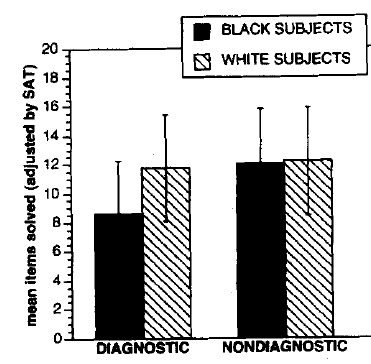Steele & Aronson (1995)
 Steele & Aronson carried out a study to show how stereotype threat may affect an individual's test performance. You can use this study for the following content in the sociocultural approach:
Steele & Aronson carried out a study to show how stereotype threat may affect an individual's test performance. You can use this study for the following content in the sociocultural approach:
Research methods used in the sociocultural approach.
The effect of stereotypes on behaviour.
The original study is available here.
The aim of the study was to see how stereotype threat affects test performance in African Americans. Steele & Aronson defined stereotype threat as being at risk of confirming, as self-characteristic, a negative stereotype about one's group.
The sample was made up of 114 male and female, black and white undergraduates from Stanford University. There were two independent variables in the study: the race of the participant and the test descriptions. The participants were given a standardized test of verbal ability - similar to the SAT - and were told one of two things: 1. It is a test to diagnose your intellectual ability; 2. it is a test of your problem-solving skills; In the first condition, the focus was on "verbal ability"; in the second condition, it was on "problem-solving." Participants were randomly assigned to one of the two conditions; however, they made sure that there were equal numbers of participants in each condition.
The following graph shows the mean test scores under each condition. There was no significant difference between male and female participants, so gender is not included.

As you can see, African Americans did poorly when they believed that the test was a test of their ability, but did just as well as the white Americans when they believed that it was a test of their problem-solving skills. In other words, African American participants performed less well than their white counterparts in the stereotype threat condition, but in the non-threat condition, their performance equaled that of their white counterparts.
- The sample was made up of Stanford University students, so it may not be representative and thus difficult to generalize the findings.
- The study made use of an independent samples design. Verbal scores from participants' SATs were collected prior to the study in order to make sure that they were all within the norm of verbal performance. In this way, participant variability was minimized. However, a matched-pairs design may have been a better approach.
- Although there is a difference between the two average scores, it does not necessarily mean that the participants experienced stereotype threat. Their salience about their racial identity and their levels of stress during the exam were not measured in this first variation of the experiment. Later variations of the experiment showed, however, that this was most probably the case.

 IB Docs (2) Team
IB Docs (2) Team
